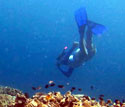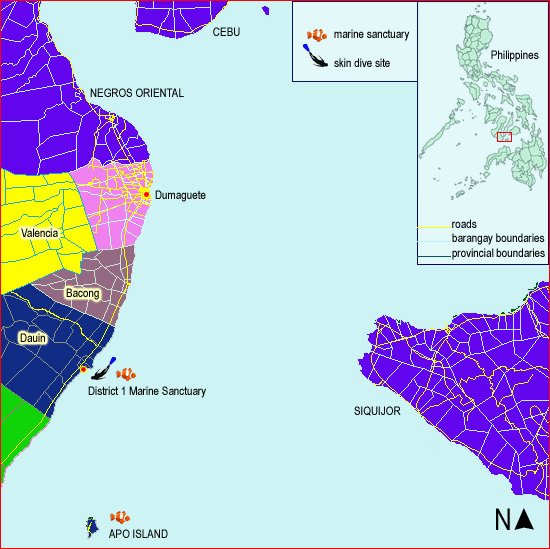

Sep 13, 2010
Coral Bleaching in Dauin
Dive Location: District 1 Marine Reserve, Dauin, Negros Oriental
El Niño
El Niño has wreaked havoc on the coral reefs of the Philippines (and Southeast Asia) in the last few weeks due to increased water temperature and lack of wind and current to dissipate the penetration of the sun's damaging rays on the reef system. Result? Coral bleaching.
What is Coral Bleaching?
With too much heat and not enough wind or current to dissipate that heat, the coral polyps get rid of their epidermal algae layer (zooxanthellae) which gives them nutrients and color. The polyps then starve, die and turn white. As reef building corals live near their upper thermal tolerance limits, small increases in sea temperature (.5 1.5 degrees C) over several weeks or large increases (3-4 degrees C) over a few days will lead to coral dysfunction and death.
Marine Biologists at the Scene
When marine biologists Rene and Nadia invited me to join them on their occular of the bleaching at Dauin's District 1 Marine Reserve, I started packing my gear. I wanted to see this for myself specially since it affects what I consider my personal playground - District 1. Yeah, it's also personal. Their report will be submitted to a reef-watch organization to build a database about the Philippines' coral bleaching phenomenon.
The Dive
On the shallows (10 feet), I already saw bleached elkhorn corals uprooted and just laying on their sides. When they can't recover from the bleaching, they die and lose their grip on the sea bed. With wave and tide action, they easily get uprooted. In time, they'll be reduced to rubble. This is a harrowing fate that awaits those who won't survive this bleaching episode.
Widespread Bleaching
There was widespread evidence of the bleaching. Some corals displayed bleaching on their outer edges, some on one side, some on their top half, etc. Even sea anemones showed discoloration as their health is consequently affected by the corals its rooted on.
Then and Now
It's surprising how fast the bleaching has spread. In my previous dive not too long ago, this reef system was the pin-up poster for a vibrant coral reef. It was diversified, colorful, healthy and teeming with marine life. Now, it's fighting for dear life.
What can we do about Coral Bleaching?
The sad answer to that is nothing. El Niño is a recurring climate anomaly. But by monitoring the extent of the damage, we get a better sense of how bad the situation has become and on what areas we need to focus our resources on. With this mandate, widespread protection can be given to stressed reef systems against man-made activities that aggravate recovery.
Lingering Thought
When this reef system dies, a part of us dies with it. We're all in this together.
--- TheLoneRider
Thanks to Rene and Nadia for tagging me along...and for the heads-up on coral bleaching.
- take a tricycle and ask to be dropped-off the jeep terminal going to Dauin (the terminal is near Robinson's Place) - P8.
- at the terminal, board the next jeep for Zamboanguita or Siaton or Dauin. Just tell the driver to drop you off at Dauin's Poblacion District 1 Marine Sanctuary. P15, 40 minutes.
- upon disembarking at the highway (almost immediately after Dauin's Poblacion), walk towards the beach...5 mins.
- pay P50 (snorkeling, all day) or P150/scuba dive to the caretaker and dive!
All pictures courtesy of Rene and Nadia Abesamis

091310
»» next story: Nomadic Existence: A Return to the Default World
»» next Skin Diving story: Apo Island with Bianca and Gianne
»» back to Skin Diving
»» back to Homepage
ARCHIVE 2025:
JAN |
FEB |
MAR
1970 |
1973 |
1975 |
1976 |
1979 |
1981 |
1996 |
2000 |
2001 |
2002 |
2003 |
2004 |
2005 |
2006 |
2007 |
2008 |
2009 |
2010 |
2011 |
2012 |
2013 |
2014 |
2015 |
2016 |
2017 |
2018 |
2019 |
2020 |
2021 |
2022 |
2023 |
2024 |
2025 |
ALL BLOGS
|


